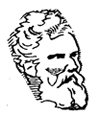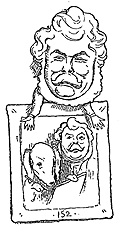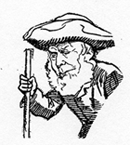
James Clarke Hook and Other Artists
The Hooks numbered many artists among their friends and associates. Here are some of the principal ones, sometimes illustrated by Linley Sambourne from his group caricatures in Punch. From Juliet McMaster's listing in Woman Behind the Painter: The Diaries of Rosalie, Mrs. James Clarke Hook, and presented here with the kind permission of the University of Alberta Press.

Richard Ansdell
Ansdell, Richard, R.A. (1815-85), was a sporting and animal painter from Liverpool, who painted Scottish subjects in Landseer's manner. Like other members of the Etching Club, he lived in Kensington in the 1850s. In 1856 he went with John Phillip to Spain, and thereafter painted many Spanish subjects. The Hooks visited him at his summer home in Scotland.

Thomas Oldham Barlow
Barlow, Thomas Oldham, R.A. (1824-89), was an engraver, engraving plates after John Phillips, Millais, Turner, Landseer, and others. As it was particularly difficult for engravers to get elected to the R.A., his election was a time to celebrate. On the death of Samuel Redgrave, Barlow took over as Secretary of the Etching Club. For many years JCH co-hosted "Academy Sunday" in Barlow's studio at Auburn Lodge, 38A Victoria Street. The Hooks travelled with him and Samuel Palmer to Inverness in August 1874.

Philip Hermogenes Calderon
Calderon, Philip Hermogenes, R.A. (1833-98), a painter of domestic and historical scenes, leader of the St. John's Wood Clique, and an occasional attender at meetings of the Etching Club. His "Broken Vows" made a sensation at the Royal Academy exhibition in 1857. His father, a Spaniard, was a Professor of Spanish Literature at King's College. Calderon was elected Keeper, or instructor at the R.A. Schools, following JCH's brother-in-law Pickersgill in that position.
Cooke, Edward William, R.A. (1811-80), was like JCH a painter of marine scenes. He was also a scholar, botanist, and Fellow of the Royal Society. Trollope quipped of one of his heroes that he "did not know a Cooke from a Hook" - clearly a mark of egregious ignorance of the art scene (Ralph the Heir, chapter 48).

Charles West Cope
Cope, Charles West, R.A. (1811-1890), a painter of genre and literary subjects, and also an illustrator and founding member of the Etching Club. Like Rosalie Hook, he first attended Sass's art School in Bloomsbury, then went on to study at the RA Schools. His painting of "The Council of the Royal Academy selecting pictures for the Exhibition" of 1876, now in the Royal Academy, shows JCH as the figure animatedly commenting on the picture before the committee. Allan Hook comments that his father in old age remembered and talked "about the Copes [father and son], Redgraves, and other old friends" (letter of 15 May 1904).

Henry William Davis
Davis, Henry William Banks, R.A. (1833-1914), a popular painter of landscape, often in Wales. When he visited the Hooks at Silverbeck, where he was photographed, he was called on to help put out a fire. Sambourne clearly used a photograph obtained from the Hooks on this visit as the basis of his drawings for Punch.
Dobson, William Charles Thomas, R.A. (1817-98), painter and watercolourist of genre and historical subjects and children, and a visitor to Silverbeck, where he was photographed. At least two of his exhibited paintings, "Children's children are the crown of old men" (1875) and "Bianca Capella" (1883), echo the titles of early paintings by JCH, suggesting close professional association. Allan Hook named Dobson as one of a handful of close lifelong friends of his parents (A.J. Hook 51).
Foster, Myles Birket (1825-99). Best known as a watercolourist and for his scenes of rural Surrey, he started his career as an engraver and illustrator for Punch and the Illustrated London News. After the Hooks moved out of their house in Hambledon, he bought their home, and then moved to a larger house which he built nearby. He and his family remained friends and exchanged visits with the Hooks, and their sons practised photography together.

William Powell Frith
Frith, William Powell, R.A. (1819-1909), the highly popular painter of large social scenes like "Derby Day" 1858, and "The Railway Station" 1862. Allan Hook records that Hook sent one of his farm workers, a man called Chitty, to act as a model for "Derby Day," and Chitty appears as the genuine country worker in a smock.
Gibbs, Henry (fl. 1865-1901), a painter, like JCH, of coastal landscapes; and some of his exhibited paintings were of places, such as Land's End, where JCH had painted before him. Like Bryan Hook, he won a gold medal at the Royal Academy Schools. He was a close friend of the Hooks, and a frequent visitor at Silverbeck. He also painted portraits, including one of F.R. Pickersgill, JCH's brother-in-law.
Haden, Seymour, a surgeon and amateur artist, and a member of the Etching Club from 1863. In pushing through a motion that was uncongenial to the membership, he caused some dissension in the Club (A.J. Hook 295). In 1879 he published a book on Rembrandt's etchings, and also founded the Royal Society of Painter-Etchers, which he persuaded JCH to join. He was brother-in-law to both J.C. Horsley and Whistler (unlikely associates), and Whistler also quarelled with him.
Hannah, Robert (1812-1909), a London painter of genre subjects and portraits, and a long-time friend and associate of the Hooks, who usually spent time with the Hannahs at Academy Exhibition time in May. In 1859 he exhibited a portrait of "James Clarke Hook, Esq.., A.R.A."
Hayter, Angelo Collen (fl. 1848-52) was an amateur painter who became a friend of the Hooks in Florence, and travelled with them to Rome and Naples. He exhibited five works at the Royal Academy between 1850 and 1852, and four (including one called "Neapolitan peasants near the tomb of Virgil," probably painted on his expedition to Naples with the Hooks), at the British Institute. His friendship with Rosalie and JCH evidently lasted, for in August of 1896 he sent Rosalie a gold button-hook for her golden wedding. He must have watched JCH's rise to fame from afar, remembering their youthful travels together.

John Evan Hodgson
Hodgson, John Evan, R.A. (1831-95), a painter of genre and landscape, was like Calderon a member of the St John's Wood Clique. He became the R.A. Librarian and Professor of Painting, and with the Secretary Fred Eaton wrote The Royal Academy and its Members, 1758-1930. The photograph of him taken at Silverbeck became an image used by Sambourne in his caricatures of Academicians.
Hook, Allan J., (1853-1946), elder son of Rosalie and JCH, attended the R.A. Schools, and painted sea subjects, usually without land in them. He exhibited 28 paintings at the R.A.. After his mother's death in 1897 he and his family moved to Silverbeck to look after JCH; then after his death they emigrated to Canada, where he wrote the biography of his father, Life of James Clarke Hook, R.A., 3 vols (privately printed, 1929-32).
Hook, Bryan (1856-1925), younger son of Rosalie and JCH, won the Turner gold medal at the R.A. Schools, and became a painter and illustrator of landscape, bird, and animal subjects, exhibiting 46 paintings at the R.A. He also published a book on Milch Goats and their Management (1896). In WWI he worked in camouflaging ships. On visits to Kenya he helped found a school of realistic animal painting. His work has been used in illustrated editions of Karen Blixen's Out of Africa.

John Calcott Horsley
Horsley, John Calcott, R.A. (1817-1903), a painter of genre and historical subjects, was nephew of Sir John Calcott, R.A., and brother-in-law of Brunel and Whistler. During the 1850s he like Hook turned from mainly historical subjects to contemporary ones. A founding member of the Etching Club, he became a member of the "Cranbrook Colony" in Kent. From 1875-90 he was Rector of the R.A., and his prudish objections to paintings from the nude earned him the nickname "Clothes-Horsley"; Sambourne represents him with a blushing face.
Hunt, Alfred William (1830-96), became JCH's tenant at Tor Villa on Campden Hill after Holman Hunt (no relation). Originally from Liverpool, he won the Newdigate Prize for poetry at Oxford. When he married in 1861 he decided to become a painter. Much influenced by his friend and mentor Ruskin (Newall 27), he regularly exhibited his landscapes at the Royal Watercolour Society and the R.A. JCH saw in his studio "a lovely bit with trees and sunny slopes and an old castle" (letter of 11 October 83). His wife Margaret Hunt (1831-1912) was a noted novelist, and probably the main breadwinner: it was she who paid JCH the rent while they were his tenants. The family, including the daughters Violet Hunt the novelist (1862-1942) and Venetia and Sylvia, became family friends, and exchanged visits with the Hooks.
Hunt, William Holman (1827-1910), painter of religious and Eastern subjects, one of the original seven of the Pre-Raphaelite Brotherhood, and with Millais the most prominent. He fell afoul of the R.A. establishment, and though initially he would have liked the status for the commissions it would bring, subsequently when the Academy courted him he turned them down. He became a member of the Etching Club (nominated by JCH) in 1856, and then a tenant at Tor Villa when the Hooks moved to the country in 1857. His son Cyril Benone also visited the Hooks at Silverbeck in 1874 (see correspondence in the Huntington Library).

Charles Keene
Keene, Charles (1823-91), an illustrator most famous for his work for Punch, moved into Tigbourne Cottage at Hambledon (once the Hooks') after Myles Birket Foster moved out. He visited Silverbeck, and was photographed there.

Sir Edwin Landseer
Landseer, Sir Edwin, R.A. (1802-1873), most famous as an animal painter, early made an etching from a lion that JCH's father had sent back from Sierra Leone (Stephens 2). The Hooks bought two of his paintings, one of which is still in the family.

Frederic Leighton
Leighton, Frederic, Lord Leighton, P.R.A. (1830-96), painter of Roman and mythological subjects, was President of the R.A. (following Eastlake and Grant, and then followed by Millais and Poynter) for much of JCH's career as an academician. JCH bought his bronze sculpture, "Needless alarms" (1886), which decorated the Silverbeck drawing-room. Leighton called JCH "as true and purely English an Artist as Turner or Constable themselves" (letter of 18 Nov 82.).
Lewis, Arthur (1824-1901), belonging to a successful department store that was "mercer to Her Majesty Queen Victoria," was also a portrait painter and landscapist. He moved to Moray Lodge on Campden Hill among JCH's London tenants and associates, and hosted high society parties. He founded the Junior Etching Club. The Lewises and the Hooks exchanged visits.

Millais & Hook
Millais, John Everett, P.R.A. (1829-96), the most famous of the seven original Pre-Raphaelite Brotherhood, and probably the best known Victorian painter. He was only 18 when he won the R.A. Schools' gold medal for historical painting, the same that JCH had won the previous year. He was elected President of the R.A. only months before his death. As a fellow student, close friend of the Hooks' tenant Holman Hunt, and member of the Etching Club, he was a close associate of JCH on several fronts. His portrait of JCH, exhibited in 1883 (and still in the family), drew enthusiastic praise, and increased the reputation of both men. In return, Hook painted for Millais "The mirror of the sea-mew" (1884).
Morley, Robert (1857-1941), a painter of human and animal subjects who moved to Tilford near Silverbeck in 1892. He became a friend and tutor of JCH's grandchildren, as well as a neighbour, and painted a portrait of Valentine Hook, the grandson who was killed in WWI.
Opie, Edward (1810-94, great-nephew of John Opie, R.A.), a painter of portraits (including one of JCH), rustic and historical subjects. He was JCH's first instructor in painting (A.J. Hook 37) and became a lifelong friend, exchanging visits with the Hooks between Silverbeck and his home in St Agnes, Cornwall.
Palmer, A. Herbert, son and biographer of Samuel Palmer, and his assistant in printing etchings, was an accomplished photographer and draughtsman, as demonstrated by his portrait of his father in his Life and Letters. He lived some time in Sennen and then in Tilford, and was a frequent visitor to Silverbeck, as well as the author of a series of articles on JCH published in Portfolio in 1888.
Palmer, Samuel (1805-81), painter of pastoral landscapes, illustrator and etcher, and the most important follower of William Blake. Though Ruskin praised him, his work (which seems quite modern) was not fully appreciated until he was "discovered" in the 1920s. A founding member of the Etching Club, he became very fond of the Hooks, and visited them first at Hambledon and then at Silverbeck, which he called "Elysium." Photographs of both Samuel and A.H. Palmer are in the Silverbeck album.

John Pettie
Pettie, John, R.A. (1839-93), was born in Edinburgh, and became a Scottish historical painter. When he moved to London in 1862, he shared a studio with Orchardson. He attended some meetings of the Etching Club, though he may not have been a member. He was photographed at Silverbeck.

Frederick George Pickersgill
Pickersgill, Frederick George, R.A. (1820-1900), one of a family of artists, was a fellow student with JCH at the R.A. Schools, and married Hook's sister Mary Noorooz Hook; after her death her sister Rosa came to live with him. A painter of historical genre subjects, from 1873 to 1887 he was the Keeper, or superintendent of the R.A. Schools, and his nephews Allan and Bryan Hook were among his students. Because of this position, he virtually gave up exhibiting his own work. He retired to Yarmouth on the Isle of Wight, where the Hooks visited him.

Richard Redgrave
Redgrave, Richard, R.A. (1804-88), a noted genre and landscape painter, is best known for his subjects of social significance, like "The sempstress" (based on Hood's "The Song of the Shirt") and "The governess." With his brother Samuel, who was also a member of the Etching Club and worked hard as its secretary, he was co-author of A Century of British Painters (1866), which is still a useful source. He retired from the R.A. well before his death because of his increasing blindness. A dictated letter of resignation to Barlow, the Club secretary, reads in part, "I feel I shall never etch again and from my blindness I am not able to attend meetings.... It is however satisfactory to see how much the love of Etching has been spread abroad no doubt largely by means of the Club" (2 February 1882).
Reid, Sir George (1841-1913), established himself as Scotland's leading portrait painter, working in Aberdeen and then in Edinburgh. He painted JCH's portrait as part of the collection of portraits and self-portraits commissioned by Alexander Macdonald of Aberdeen, and he and his wife visited the Hooks in 1893, after he became President of the Royal Scottish Academy and was knighted.
Sambourne, Edward Linley, (1844-1910), illustrator and long-term member of the Punch staff. Besides illustrating Punch's "Essence of Parliament" series, he provided group pictures of the academicians each year during the 1880s, at R.A. Exhibition time - from which the illustrations here are largely drawn. JCH bought the original for the 1882 group. Sambourne visited Silverbeck along with W.H.B. Davis, R.A., and he seems to have used some of the Hooks' photographs (of which he requested copies) for his drawings. Soon after his visit to Silverbeck, and probably as a result of it, he bought a camera of his own, and subsequently developed a huge archive of photographs to be used for his graphic work.
Stephens, Frederick George (1828-1907), one of the original seven of the Pre-Raphaelite Brotherhood, and initially a close associate of Holman Hunt. He turned from painting to art criticism, and after writing for The Germ he became the art editor for the Athenaeum, a position which he held for some four decades. He wrote studies of a number of artists, including a biography of JCH (the Art Annual for 1888). He and his wife became close friends of the Hooks, travelled with them to Wales and several times to the Paris salon, and often visited Silverbeck. He became the godfather of one of Bryan Hook's sons, Valentine Hook.
Watts, George Frederic, R.A. (1817-1904), painter of a wide range of subject matter, including portraits and (by preference) historical and mythological subjects, was also a sculptor. His long and productive career paralleled JCH's, and they were long-time associates. They had been students together at the Royal Academy schools, and Rosalie seems to have known him before they met again in Florence, where Watts was staying with his patrons Lord and Lady Holland. Much later in their lives, Watts and JCH co-hosted "Academy Sunday" gatherings - the important pre-exhibition social occasions where artists and buyers could meet socially - in Watts' studio at Little Holland House on Melbury Road in Kensington. Since JCH lived in the country, he was glad to have friends, like Watts and T. O. Barlow (who died in 1889), with studios in London that he could share for the occasion. The Hooks visited Watts at his Guildford home Limnerslease, now the Watts Museum.

James Whistler
Whistler, James A. McNeill (1834-1903), the American-born, Paris-trained painter, famous for his aesthetic subjects and his suit against Ruskin, was a friend and admirer of JCH, who became host to Whistler's Paris associate Henri Fantin-Latour.
Wyllie, William, R.A. (1851-1931), attended the R.A. Schools with Allan and Bryan Hook, and like Bryan won the Turner gold medal. He and Allan both painted marine and dockside scenes. He was something of a protegé of JCH, who bought his work and that of his brother Charles, and nominated him for election to Associateship. Both brothers and their wives figure in the Silverbeck Album; and Charles's wife Charlotte was also a painter who is now receiving recognition.